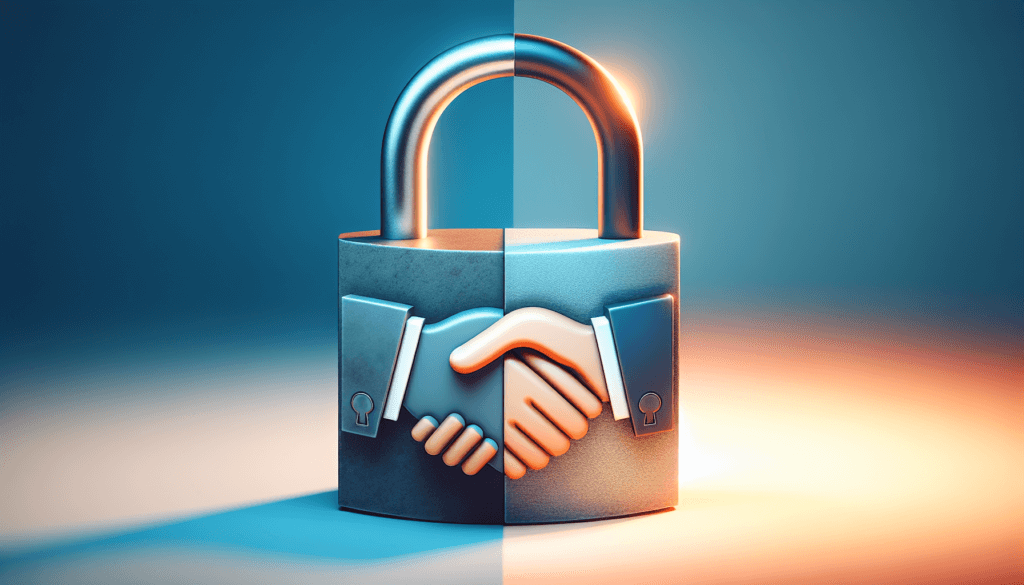So you’ve worked hard to build your blog, and now you’re ready to start monetizing it. But you may be wondering, how can you protect your blog’s brand and reputation while doing so? It’s a valid concern, as bloggers often face the challenge of striking a balance between making money and maintaining authenticity. In this article, we will explore some essential tips and strategies to help you navigate this delicate balance, ensuring that your blog remains a trustworthy and valuable resource for your audience, while still allowing you to monetize it successfully.

Choosing a Strong Blog Branding
Creating a Memorable Name
When it comes to choosing a blog name, it’s important to create something that is easy to remember, reflects the content and purpose of your blog, and stands out from the competition. Consider using unique and creative words or phrases that are relevant to your niche. Avoid using generic or overused terms that may make it difficult for readers to distinguish your blog from others. Additionally, consider the potential for growth and expansion in the future when choosing your blog’s name.
Designing a Unique Logo
A well-designed logo can help reinforce your blog’s identity and make it easier for readers to recognize and remember your brand. Your logo should be visually appealing, unique, and relevant to your blog’s content. Hire a professional graphic designer if needed to ensure your logo is high-quality and reflects your brand’s personality. Remember to keep your logo consistent across all your online platforms for better brand recognition.
Developing a Consistent Visual Identity
Consistency is key when it comes to building a strong blog brand. Establish a cohesive visual identity by deciding on a color scheme, typography, and overall design style for your blog. Try to align these visual elements with the nature and tone of your blog’s content. Consistently apply your visual identity in your logo, website design, social media posts, and any other branding materials. This will help create a cohesive and professional look that resonates with your readers.
Building a Trustworthy Reputation
Consistently Producing High-Quality Content
One of the most effective ways to build a trustworthy reputation is by consistently producing high-quality content. Ensure that your blog posts are well-researched, informative, and engaging for your readers. Proofread your content for any grammar or spelling errors and use reliable sources when providing information. Remember that quality content will help establish your expertise and credibility in your chosen niche.
Engaging with your Readers
Building a strong relationship with your readers is crucial in establishing trust. Respond to comments and messages promptly and thoughtfully. Encourage conversation and interaction through your blog’s comment section or social media platforms. Show appreciation for your readers by asking for their feedback, opinions, and suggestions. By actively engaging with your audience, you will foster a sense of community and loyalty.
Implementing Transparency and Disclosure
Transparency is essential for building trust with your audience. Be open and honest about your affiliations, sponsorships, and any potential conflicts of interest. Clearly disclose any sponsored content or affiliate links within your blog posts. Provide disclaimers when necessary, especially when offering advice or recommendations. By being transparent and maintaining integrity, you will gain the trust and respect of your readers.

Understanding and Respecting Copyright Laws
Educating Yourself About Copyright
As a blogger, it’s essential to understand copyright laws to avoid infringing on other creators’ rights. Educate yourself on the basics of copyright, including what constitutes infringement and how to properly attribute copyrighted material. Stay up-to-date with any changes in copyright laws and seek legal advice if you have any doubts or concerns.
Using Proper Attribution for Images and Quotes
When using images or quotes created by others, always give proper attribution. Provide clear credit to the original source and respect any usage restrictions or licenses. Avoid using copyrighted content without permission or proper attribution, as this can lead to legal consequences and damage your blog’s reputation.
Seeking Permission for Republishing Content
If you wish to republish someone else’s content, always seek permission from the original creator or copyright holder. Respect their intellectual property rights and ensure that you have their explicit consent to republish their work on your blog. Failure to obtain permission can result in legal issues and damage your blog’s credibility.
Protecting Intellectual Property
Trademarking your Blog Name and Logo
To protect your blog’s brand identity, consider trademarking your blog name and logo. Registering a trademark will provide legal protection against others using a similar name or logo within your industry. Consult a trademark attorney to guide you through the process and ensure that your blog’s brand is properly protected.
Registering your Copyright
Even though your blog content automatically receives copyright protection, it is still advisable to register your copyright with the appropriate intellectual property office. Registering your copyright will provide you with additional legal protection and make it easier to enforce your rights if someone infringes on your content.
Monitoring and Enforcing your Rights
Regularly monitor your blog’s content and branding to ensure that no one is unlawfully using your intellectual property. Keep an eye on other blogs and websites within your niche and be vigilant for any unauthorized use of your content or brand assets. If you come across any infringements, take appropriate action, such as sending cease and desist letters or pursuing legal action if necessary.

Maintaining Ethical Monetization
Choosing Relevant and Authentic Advertising
When monetizing your blog through advertising, ensure that the ads align with your blog’s content and values. Choose advertisements that are relevant to your niche and genuinely beneficial to your readers. Avoid partnering with companies or promoting products that you don’t believe in or that may be misleading to your audience. By maintaining ethical advertising practices, you will preserve your blog’s integrity and readers’ trust.
Disclosing Sponsored Content Properly
Full disclosure is crucial when it comes to sponsored content. Clearly label any blog posts, social media posts, or videos that include sponsored content. Use standardized disclosures, such as “This post is sponsored by [Brand],” or “In collaboration with [Brand].” Make sure the disclosure is easily visible and can be easily understood by your readers.
Avoiding Shady Monetization Practices
It may be tempting to engage in shady monetization practices to earn quick money, but this can have serious consequences for your blog’s brand and reputation. Avoid practices such as clickbait titles, deceptive advertising, or engaging in fraudulent activities. Instead, focus on building a sustainable and ethical monetization strategy that provides value to your readers while maintaining your integrity.
Effective Content Promotion and SEO
Optimizing Your Blog for Search Engines
To increase your blog’s visibility and attract organic traffic, optimize your content for search engines. Research relevant keywords and optimize your blog posts and website pages accordingly. Use meta tags, headings, and descriptions to make your content more search-engine-friendly. By implementing effective SEO strategies, you will improve your blog’s search engine rankings and gain more exposure.
Leveraging Social Media Platforms
Social media platforms provide a valuable opportunity to promote your blog and engage with a wider audience. Choose the platforms that align with your target audience and create a consistent brand presence. Share links to your blog posts, engage with your followers, and leverage social media advertising when appropriate. By effectively using social media, you can boost your blog’s reach and increase traffic to your website.
Building Relationships with Influencers
Collaborating with influencers in your niche can help increase your blog’s visibility and credibility. Identify influencers who align with your brand values and have a genuine connection with your target audience. Engage with them on social media, offer guest blogging opportunities, or participate in joint projects. By building relationships with influencers, you can tap into their audience and expand your reach.

Monitoring and Responding to Online Feedback
Performing Regular Online Reputation Management
Regularly monitor your blog’s online presence and reputation. Set up Google Alerts or use online monitoring tools to track brand mentions and discussions related to your blog. Address any negative comments or reviews promptly and professionally. Respond to positive feedback as well to show your appreciation. By actively managing your online reputation, you can address any issues before they escalate and ensure a positive perception of your blog.
Managing Negative Comments and Reviews
Negative comments and reviews are inevitable, but how you handle them can significantly impact your blog’s reputation. Respond to negative feedback in a calm and professional manner, addressing any concerns or misunderstandings. Avoid engaging in arguments or deleting negative comments unless they violate your comment policy. By handling negative feedback gracefully, you can show your dedication to resolving issues and maintaining a positive image.
Responding Professionally to Feedback
Whether it’s positive or negative, responding to feedback professionally is essential. Thank those who provide positive feedback and show appreciation for their support. When addressing negative feedback, remain calm, empathetic, and solution-oriented. Remember that your responses are visible to the public and can shape your blog’s reputation. By adopting a professional approach, you can demonstrate your commitment to listening to your audience and improving your blog.
Protecting against Cyber Attacks and Data Breaches
Implementing Strong Website Security Measures
Protecting your blog from cyber attacks and data breaches is vital to safeguard your brand and readers’ trust. Implement strong website security measures, such as using a reliable hosting provider, regularly updating security software, and employing secure server protocols. Use strong passwords and enable two-factor authentication to ensure unauthorized access is minimized.
Regularly Updating Software and Plugins
Outdated software and plugins are vulnerable to security threats. Regularly update your website’s content management system and plugins to stay protected against potential security vulnerabilities. Enable automatic updates whenever possible to ensure you’re always running the latest versions of your website components.
Backing Up Blog Content Regularly
In the event of a cyber attack or data breach, having regular backups of your blog’s content is crucial. Set up automatic backups with a reliable backup solution or schedule regular manual backups. Store your backups securely in offline or cloud storage to ensure they’re accessible if your website becomes compromised. Regular backups give you peace of mind knowing that your blog’s content can be restored in case of any unforeseen circumstances.

Establishing Legal Policies and Disclaimers
Creating a Privacy Policy
Protecting your readers’ privacy is essential, and a privacy policy is crucial in establishing transparency. Create a privacy policy that outlines the type of data you collect, how you use it, and how you protect it. Clearly disclose if you use cookies, analytics, or third-party services. Make sure your privacy policy is easily accessible on your blog, preferably in the footer or a dedicated privacy policy page.
Drafting a Disclaimer Statement
A disclaimer statement can help protect you from potential liability for the content on your blog. Draft a comprehensive and clear disclaimer that outlines the limitations and responsibilities associated with your blog. Clarify that the content on your blog is for informational purposes only and may not be applicable to everyone’s circumstances. Consult with a legal professional to ensure your disclaimer covers all necessary aspects.
Applying Terms of Use on Your Blog
Setting clear terms of use for your blog helps establish guidelines for your readers and protect your blog’s content. Outline acceptable use of your blog’s content, community guidelines, and intellectual property rights. Specify any rules regarding comments, behavior, or prohibited content. By applying terms of use, you can maintain control over your blog’s content and ensure a positive and respectful environment for your readers.
Protecting from Plagiarism and Content Scraping
Using Plagiarism Detection Tools
To protect your blog’s content from plagiarism, utilize plagiarism detection tools. These tools detect duplicate or copied content across the internet. Regularly scan your blog’s content to identify any instances of plagiarism and take appropriate action if necessary. Protecting your original content will protect your blog’s reputation and ensure that you retain ownership of your work.
Taking Legal Action against Scrapers
If you discover instances of content scraping, where others republish your blog’s content without permission, consult with an attorney about taking legal action. Understand your rights as a content creator and work with legal professionals to enforce those rights. Taking appropriate legal action not only protects your intellectual property but also sends a clear message to others about the importance of respecting content creators’ rights.
Regularly Monitoring for Content Theft
Monitor your blog’s content across different platforms to detect any instances of content theft. Tools like Google Alerts or manual periodic searches on search engines can help identify unauthorized use of your content. Stay vigilant and take immediate action if you find instances of content theft. Regular monitoring showcases your commitment to protecting your blog’s brand and original content.
By following these guidelines, you can protect your blog’s brand and reputation while effectively monetizing it. Remember that building a strong blog brand is not a one-time effort but an ongoing process. Stay proactive, adapt to changes, and always prioritize the needs and trust of your readers.


